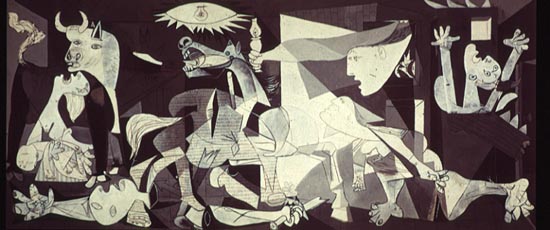
Guernica
Pablo Picasso
I chose Pablo Picasso's "Guernica" for my first artist working with social issues because he made a total commitment at a very difficult time in history. His feelings about the war were so strong, that he felt compelled to communicate them through his painting for everyone to see. Nearly everyone who has seen the original, which measures almost 11.5 feet by 25.5 feet (monumental in size by most standards), has been deeply moved by the images.The following website has a famous quote from Picasso regarding the many dimensions of an artist regarding current events and social issues: http://www.oneonta.edu/faculty/farberas/arth/arth200/guernica.html.
What do you think an artist is? An imbecile who has only eyes if he is a painter, or ears if he is a musician, or a lyre in every chamber of his heart if he is a poet, or even, if he is a boxer, just his muscles? Far, far from it: at the same time, he is also a political being, constantly aware of the heartbreaking, passionate, or delightful things that happen in the world, shaping himself completely in their image. How could it be possible to feel no interest in other people, and with a cool indifference to detach yourself from the very life which they bring to you so abundantly? No, painting is not done to decorate apartments. It is an instrument of war-- Pablo Picasso
"In 1937 Pablo Picasso painted Guernica, a mural that was the centerpiece for the Spanish Pavilion of the World's Fair in Paris. The official theme of the Paris Exposition was the celebration of modern technology. The Aeronautics Pavilion, featuring the latest advances in aircraft design and engineering, was a centerpiece of the exposition. It is a bitter irony that Guernica, the most lasting monument of the exposition, is the Twentieth century's most enduring symbol of the horrors of war and the inhumane use of technology. It is a portent for the terrors of the next decade. The painting is based on the events of April 27, 1937, when the German airforce, in support of the Fascist forces led by Generalissimo Francisco Franco, carried out a bombing raid on the Basque village of Guernica in northern Spain. At that time such a massive bombing campaign was unprecedented. The hamlet was pounded with high-explosive and incendiary bombs for over three hours. The non-combattant townspeople including women and children were indiscriminately cut-down as they fled their crumbling buildings. The town of Guernica burned for three days leaving sixteen hundred civilians killed or wounded in its smoldering remains. The Fascist planners of the bombing campaign knew that Guernica had no strategic value as a military target, but it was a cultural and religious center for Basque identity. The devastation was intended to terrorize the population and break the spirit of the Basque resistance. In effect it was intended to "shock and awe" the Basques into submission. The bombing of Guernica was a sensation in the world press. The Times of London called it the arch-symbol of Fascist barbarity.
Picasso's painting is without question the most important anti-war work of art produced in the Twentieth Century."
Things are happening around us every day. What catches your attention? What do you feel strongly about?
Here is just a brief list of the countless issues we face:
Abortion
Abuse of any sort
Age Discrimination
Alcoholism
Bullying
Child Abuse
Child Labor
Civil Rights
Discrimination
Equal Rights
Freedom of Speech/Censorship
Gangs
Gay / Lesbian / Transgender Rights
Genocide/ Violence
Global Warming
Illicit Drugs
Illiteracy
Immigration Laws
Pollution/ Stewardship
Pornography
Racism
Right to Bear Arms/Gun Control
Universal Health Care
Various Charities
War/Peace
So, give it some thought. Try a few rough sketches and see where they take you. This is an opportunity to really assert your artist's voice as well as utilizing your art akills. We're looking forward to some powerful visual statements. Mr. Exner
So, give it some thought. Try a few rough sketches and see where they take you. This is an opportunity to really assert your artist's voice as well as utilizing your art akills. We're looking forward to some powerful visual statements. Mr. Exner
No comments:
Post a Comment